I stepped carefully over the faded yellow, green and red bricks, pausing whenever a spot of turquoise or royal blue caught my eye –fragments of ceramic mixed in with the city ruins. I tried to follow the vague path that seemed to lead over the dirt mounds that once formed city walls, afraid that one misstep would trigger a mini-avalanche of bricks. Eventually the path took me down the other side of the walls and into the heart of what was once the city of Misrian.
Piles of dirt and bricks surrounded me, the remains of ancient stores and houses. Plants peaked out between the stone and clay and the ground was conspicuously free of footprints. I spotted more bits of blue and turquoise ceramic, together with broken pieces of orange pottery. In the distance, I could see two large minarets and what remained of the Mosque of Mohammed II, Shah of Khorezm.


Later that night, as I climbed the dilapidated stone stairs of one of the minarets (dating back to the 9th century!) to watch the sun set, I wondered how long it had been since anyone else had enjoyed the same view.
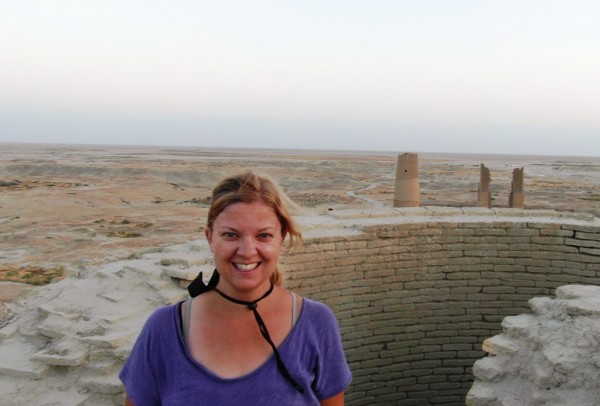
The area around Misrian was settled in the third millennium B.C. and from the 8th to 14th centuries, it was a major stopping point for Silk Road caravans traveling from Khorezm (in what is now Uzbekistan) to Ghirkania (now northern Iran). But then the climate changed and the rivers running near Misrian dried up. And the city that once rivaled Samarkand and Bukhara in prestige and importance was soon abandoned.
Today Samarkand and Bukhara are thriving cities that attract throngs of tourists to their centuries-old mosques and madrassahs, many carefully renovated and restored to their former glory.
But Misrian stands quiet and, for the most part, untouched.
While the golden road to Samarkand is now asphalt, the road to Misrian is nothing but dirt. No buses or marshrutkas or taxis will take you there. Only a four-wheel drive will do to navigate the dozens of kilometers of bare desert roads. Just before reaching Misrian, you can visit a recently renovated 12th century mosque (which was likely once a Zoroastrian temple), surrounded by a cemetery and several crumbling mausoleums.
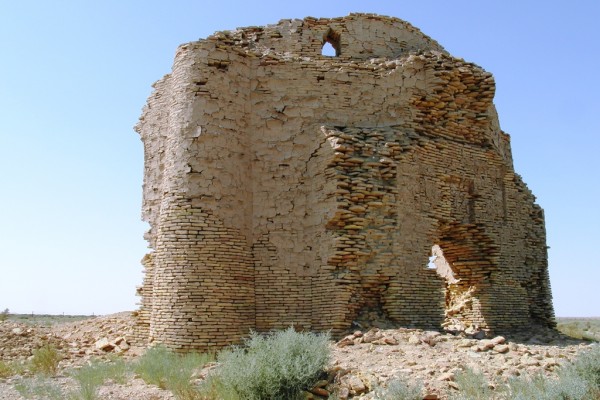
Once you arrive, the ruins of the city lie open and exposed, with just the foundations of a few buildings fully excavated. No ticket office stands at the entrance and no guards watch over you as you explore. Indeed, I spent the night camping between the ruins of the inner and outer city walls and no one was around to care.
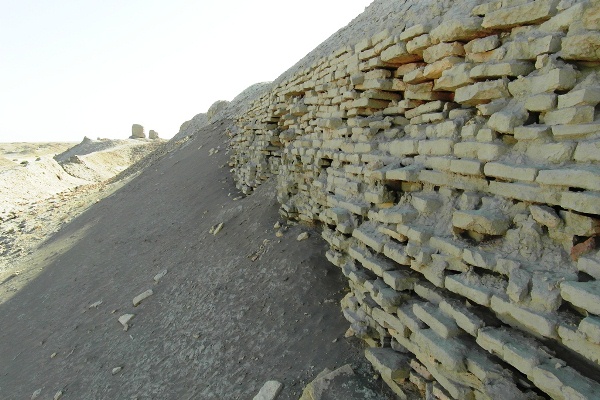
The same is true for Abiverd.
From the 9th to 13th centuries, Abiverd was a major trading post on the Silk Road. The city had a well-developed system of water supply, minted its own coins and was known for its pottery. But like many cities in Central Asia, Abiverd never really recovered after the Mongols rolled through in 1221. Today, remains of the town are visible just off the road from Mary to Ashgabat, including the old city walls and dozens of mud-brick buildings.
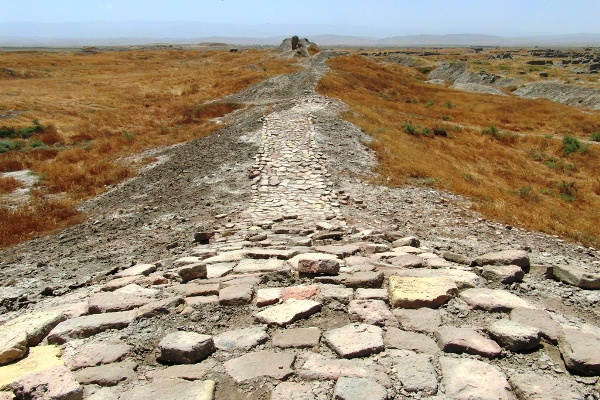
But the most important Silk Road city in Turkmenistan may have been Merv.
Some say Merv was the largest city in the world back in the 12th century with a population of around 200,000. It was a convergence point for the northern and southern routes of the Silk Road and was considered by some to be the capital of the eastern Islamic world. Fittingly, today it is one of just three UNESCO World Heritage Sites in Turkmenistan (the Nissa Fortress and the site of another Silk Road city, Kunye Urgench, are the others) and probably the best known.
The ruins at Merv aren’t all as raw as in Misrian or Abiverd – a few buildings have been renovated and actually have explanatory signs in English. But for the most part, it has a similar feel but on a larger scale. Climbing to the top of the walls of the Erk Kala, I could see the different sections of the former city – the Persian town, the Greek town, the Seljuk town – each having its own history, creating a layering effect throughout the site.
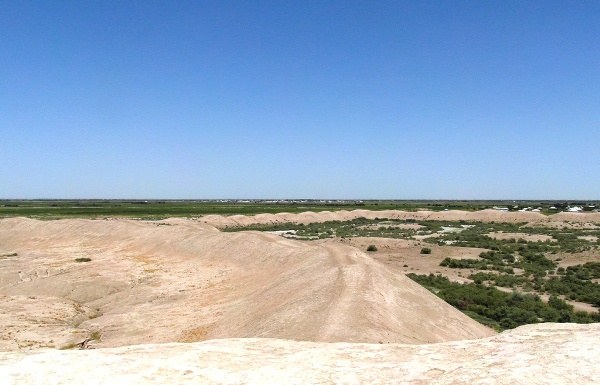
While many of the old city walls have been blown over with sand, I stopped at one wall where the old bricks are still visible. Different-sized bricks reveal the ages of various sections of the wall – the oldest being built in the 4th century B.C., while expansions of the wall dated to the 5th century A.D. – a span of 1000 years of history right there in front of my eyes.
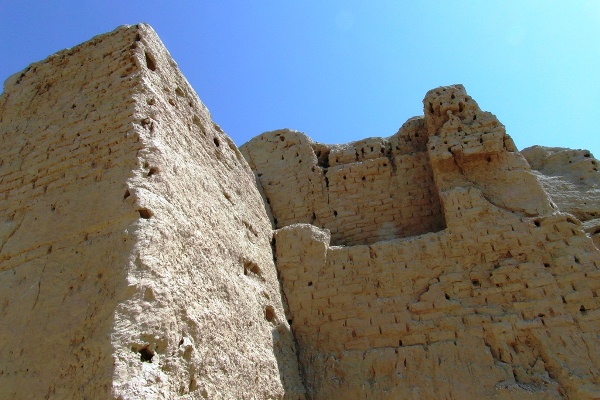
The most impressive remains are those of the castle known as the Great Kyz Kala. Originally thought to date to the 11th century, the bricks are of a size used in Persian times and there is a 6th century plate at the Hermitage in St. Petersburg that shows a very similar structure. Thus, I was likely walking around a building that has been standing for at least 1500 years.
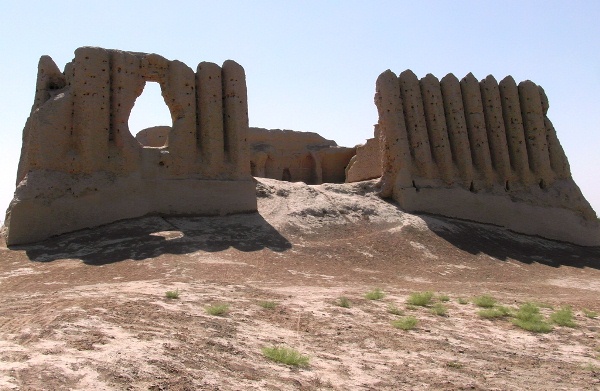
The Mongols attacked Merv in 1221 and murdered all of its inhabitants. A century later, the city tried to make a comeback, becoming the seat of a Christian archbishopric for the Eastern Orthodox church and later being pulled into Timur’s empire. The Persians later captured Merv, followed by the Emir of Bukhara who, in 1785, destroyed the city and deported the entire population.
In a game of survival of the fittest, Merv lost.
As did Kunye Urgench (also a Silk Road superpower, razed to the ground by the Mongols) and Misrian and Abiverd and a dozen other former Silk Road oases in Turkmenistan.
As a result, today only fragments remain of these towns where caravans carrying silk, porcelain and spices once stopped, and grand mosques and fortresses once stood.
And as a result, only a small glimpse into Turkmenistan’s once glorious past survives.

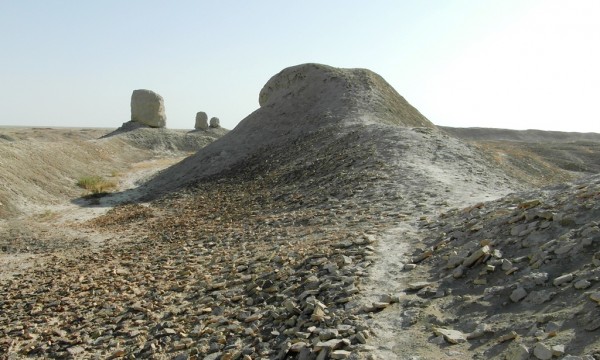
The imagination can really run wild gazing at the Great Kyz Kala I imagine. I bet camping there was surreal. I think I would dream of caravans and traders coming in through the night.
Katie,
I really love this past because you capture the essence of this historic place. Personally, I have a passion for the Silk Road and seeing what it looks like today as well as your writing, made me feel like I was there. And how cool to see that piece of pottery! Like finding an arrowhead at home, but older.
Have a great labor day weekend,
Kristin
I’m just blown away by your travels! These are such amazing and forgotten ruins. I love the part about finding scattered tiles. Thanks for sharing!
I’ve always found the Silk Road so fascinating, but so far I’ve just enjoyed the music of the region. 🙂
Fascinating! I’m a wimp. Not sure that I would have camped out there alone, but I love the fact that you did.
Well, I did have a guide with me – I don’t think I could’ve done it completely solo! 🙂